THE TRANSITION FROM C-PRINT TO INKJET
On this site, we will study the transition from c-print to inkjet, we will examine the differences between today’s two major printing technologies. We will scientifically compare the color gamuts of various printer/paper profiles. We will discuss the latest print permanence studies.
THE TRANSITION FROM C-PRINT TO INKJET
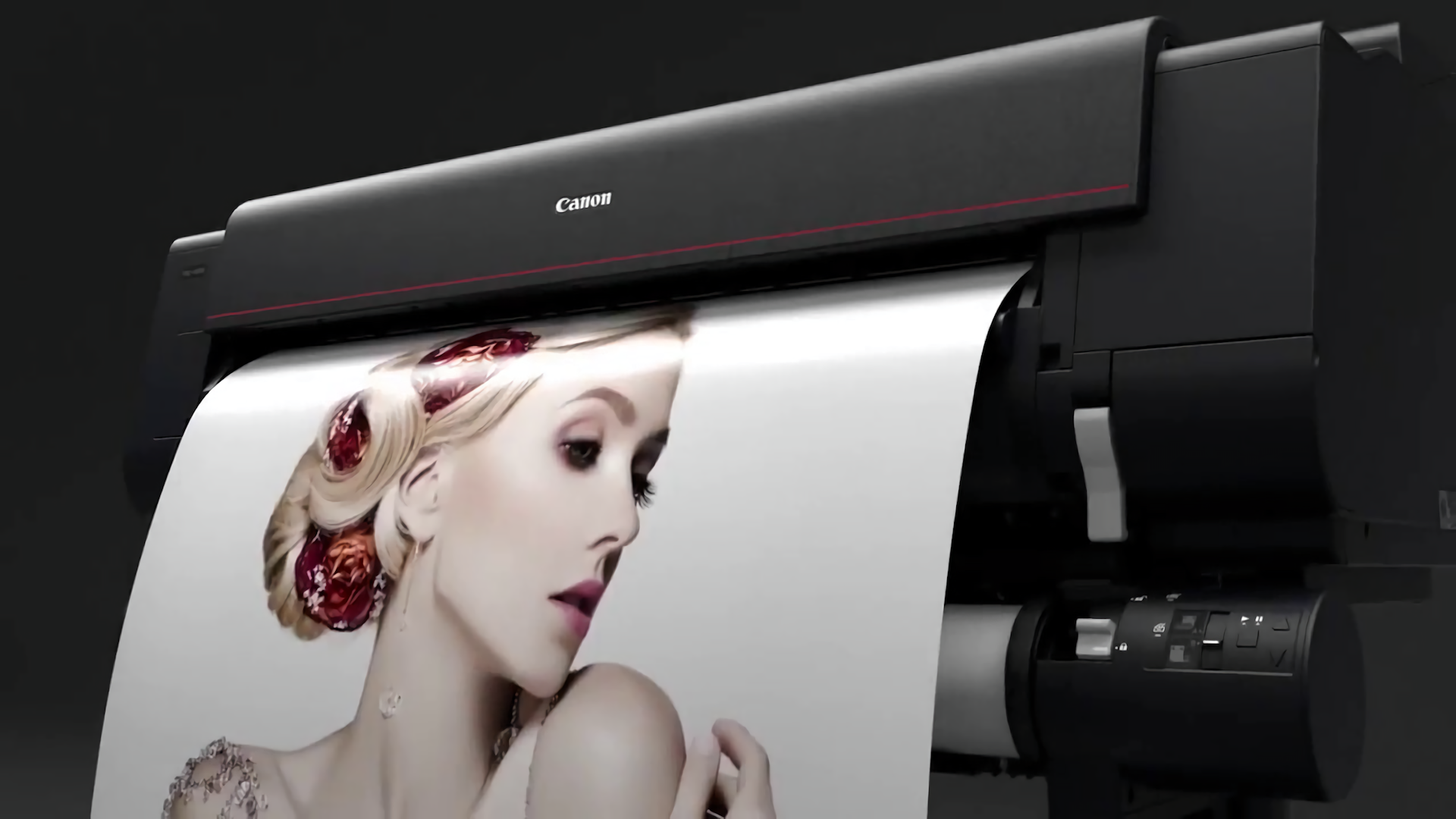
THE REVOLUTION OF INKJET
The transition from "c-print" to "inkjet" and to Fine Art print, marks a new age in the printing industry.
This tecnology is the best for quality and productivity and satisfies the printing industry.
If the same image is printed in c-print and inkjet, comparing with each other, the difference will consist of more vivid colors and sharper details. Moreover, the Inkjet tecnology with its specific papers allows you to print photos in a quality never seen before and show details that are not visible to the human eye, this details are not reproducible with the chemical print. The other advantages of the system based on inkjet technology are:
- the papers: Unlimited, infact, it is possible to print on a wide range of "materials".
- Print in Black and White perfectly Neutral and stable over time.
- Double-sided printing
- colors: print next to Adobe RGB, Gamut much wider.
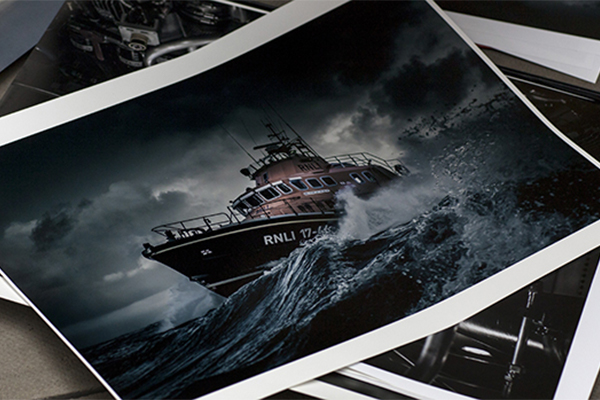

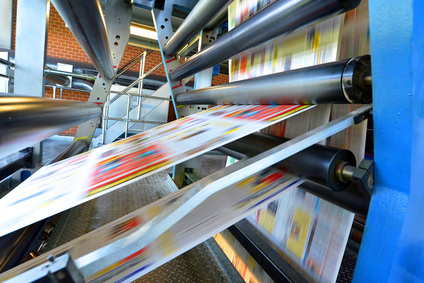
La stampa chimica
La stampa chimica è un processo di stampa che viene eseguito in grossi centri stampa, grandi negozi di fotografia o nei laboratori fotografici.Il concetto di questo tipo di stampa è: la carta fotografica su cui si andrà a stampare è *fotosensibile.
Carta fotosensibile
Una carta fotosensibile speciale dal mondo della fotografia.
Gli oggetti appoggiati su di essa, dopo essere stati esposti per un breve periodo al sole, lasceranno il proprio contorno, come se tracciati con le forbici.
Attraverso un ingranditore (per il processo di stampa tradizionale) o un fascio laser (per quello moderno) si imprime la luce negativa delle foto sulla carta, che essendo fotosensibile farà comparire la nostra immagine al positivo, poi si immergerà in un bagno chimico la carta che ne fissa i colori.
La stampa chimica in bianco e nero
Una precisazione sul bianco e nero: questo tipo di stampa è la più difficile da riprodurre in assoluto, infatti, serviranno delle competenze specifiche per ottenere dei risultati accettabili altrimenti troveremo delle dominanti anche in questo tipo di sviluppo. Molto spesso è difficile trovare un laboratorio con la L maiuscola che produca attraverso la stampa chimica un buon risultato in B/N.

THE C-PRINT
C-print is a printing process that is performed in large print centers, large photo shops or in photographic laboratories.This type of printing use the *photosensitive papers.
Photosensitive Paper
A photosensitive paper is a special paper from photografic world.
The objects positioned on this type of paper, after a brief exposure to the sun, will leave their outline as if they were traced with scissors.
An enlarger Lamp (for the traditional printing process) or a laser (for the modern one) imprint the negative light of the photos on the paper. The paper (photosensitive) will bring our image to the positive and than the paper will dives in a chemical bath to fix the colors.
The black and white c-print
A clarification on B/N print: this type of print is the most difficult to reproduce, infact, specific skills will be necessary to obtain acceptable results. Very often, a photografic laboratory capable of producing a good result in B/N with the c-print, is difficult to find.

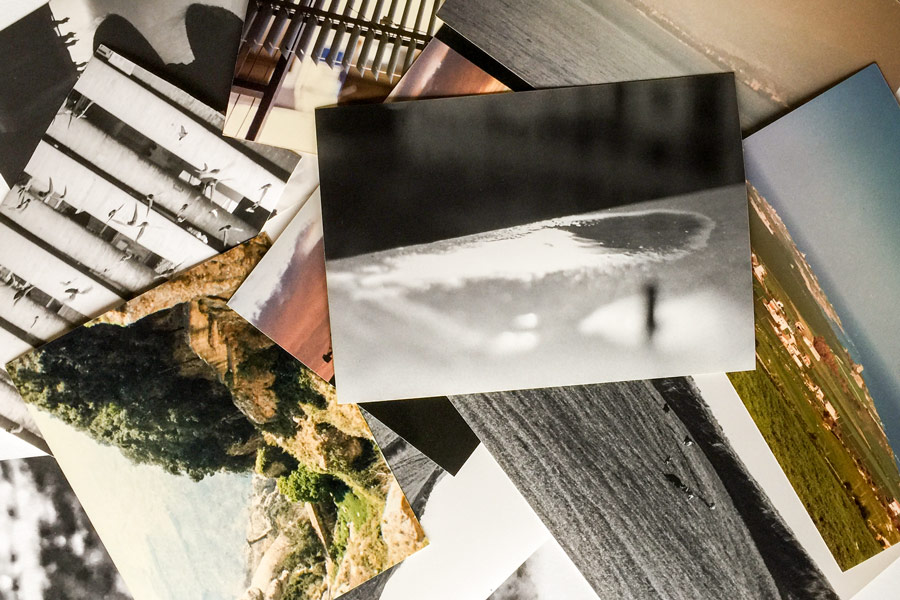
La stampa inkjet
La stampa inkjet ha al suo interno proprio la tecnologia che ritrovate nelle stampanti casalinghe. Serbatoi di inchiostro a base d’acqua, un sistema di tubicini che portano l’inchiostro ad una testina di stampa la quale spruzza minuscole gocce di inchiostro su di una superficie.Le stampanti a getto d’inchiostro non utilizzano la tecnologia *CMYK
CMYK
É la sigla di Cyan, Magenta, Yellow, Key black. È un modello di colore che viene usato nei dispositivi di stampa a colori (stampanti, plotter, ecc.) e consiste materialmente nella miscelazione di sostanze che, riflettendo solo una parte dello spettro luminoso, appaiono di uno specifico colore, quali inchiostri, pigmenti, vernici.
In questo caso, il colore riflesso è il risultato della sottrazione dallo spettro luminoso delle frequenze assorbite dallo strato di sostanze opache.
La riproduzione del colore in stampa tramite questi quattro inchiostri (ciano, magenta, giallo, nero) è detta stampa in quadricromia.
RGB
É un nuovo modello di colori di tipo additivo: i colori sono definiti come somma dei tre colori Rosso (Red), Verde (Green) e Blu (Blue), da cui appunto l'acronimo RGB.
Altri 5 colori notevoli di questo tipo di modello sono il Giallo (Rosso + Verde), il Magenta (Rosso + Blu) e il Ciano (Verde + Blu), inoltre la somma dei tre colori costituisce il Bianco, e la loro totale assenza il Nero
Queste ultime hanno al loro interno dei colori speciali che reagiscono meglio alle varie tipologie di carta.
Per esempio: se noi stampiamo bianco e nero su di una carta lucida avremo una tonalità di colore diversa rispetto a se stampassimo su una satinata e ancora una diversa rispetto ad una carta matte oppure una fine art. Se si avesse solo un tipo di nero su alcuni di questi supporti il bianco e nero verrebbe un grigetto, mentre avendo più di una tipologia di nero si otterranno delle stampe in bianco e nero perfette a prescindere dal supporto utilizzato.
Insomma la stampa inkjet è arrivata veramente ad avere una qualità tra le migliori tra i tipi di stampa digitale fin qui visti

The Inkjet print
The inkjet print is the same tecnology of the home printers. Water based inks, a system of tubes bring the ink to a print head and it sprinkles tiny drops of ink on a surface.Inkjet printers don't use the *CMYK tecnology
CMYK
It is the acronym of Cyan, Magenta, Yellow, Key black. It is a color model that is used in color printing devices (printers, plotters, etc...) and It consists materially in the mixing of substances that, reflecting only a part of the light spectrum, they appear of a specific color, such as inks, pigments, paints.
In this case, the reflected color is the result of subtracting from the light spectrum of the frequencies absorbed by the layer of opaque substances.
The print using these four inks (Cyan, Magenta, Yellow, Key black) is called four-colour process .
RGB
It is a color model additive type: the colors are defined as the sum of the three colors Red, Green and Blue.
Another 5 remarkable colors of this type of model are Yellow (Red + Green), the Magenta (Red + Blue) e il Cyan (Green + Blue), moreover, the sum of the three colors constitutes White and their total absence is Black.
These latest printers have special colors inside them that react better to the various types of paper.
For example: If B/N photo is printed on glossy paper, it will have a different color compared to the same photo printed on satin paper or on matt paper or on fine art. If the printer had one type of black, the B/N photo will be print in a gray tone, while, if the printer had more black cartridges, the black and white prints will be perfect on any supports.
The inkjet print has the best quality among the types of digital printing.
FINEART PRINT
In its more complex meaning, "Fine Art prints" does not refer only to the final printing phase but It refer to the entire production process that accompanies the photographer from the moment of shooting to the final print of the work. The differentiation between a classic print and a Fine Art print, it is a long story. The Fine Art must guarantee a series of quality and durability specifications, in addition to the value given by the artist. Quality must satisfy the primary requirement of visual satisfaction, the prints must have a large tonal extension and must be capable of reproducing intense white without the use of optical brighteners, the paper must be free of acids or perishable chemical components during the time. Prints must last at least 60, during the indicated time, there will be no alterations / variations of chroma (color), contrast and overall brightness of the imagePHOTOGRAPHIC COMPARISON BETWEEN THE FINE ART PRINT AND THE CHEMICAL PRINT
Some of the best photographers adopted Fine Art prints because they are able to extract details, gamut and depth that the c-print hides.We leave below a series of photographic comparisons.
Look carefully at the images, colors, lights, details (the images have been printed in the format 20x30cm with Fine Art paper).
Scroll the slider to the right and left to compare the two photos.





PHOTOGRAPHIC COMPARISON BETWEEN THE FINE ART PRINT AND THE CHEMICAL PRINT
Some of the best photographers adopted Fine Art prints because they are able to extract details, gamut and depth that the c-print hides.We leave below a series of photographic comparisons.
Look carefully at the images, colors, lights, details (the images have been printed in the format 20x30cm with Fine Art paper).
Scroll the slider to the right and left to compare the two photos.
Diego Russo
MINILAB DRYLAB
Drylab solution
The inkjet replaces more and more chemicals products. In recent years, there have also been significant changes in the Minilab Drylab and the number of images printed on inkjet paper continues to increase.The advantages of a drylab are:
- Low investment costs;
- Low printing costs;
- Simple and intuitive operation;
- Free of odors;
- Low energy consumption of about 120W;
- Wide range of colors;
- Wide choice of supports.
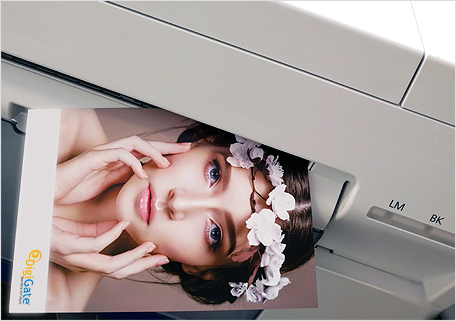

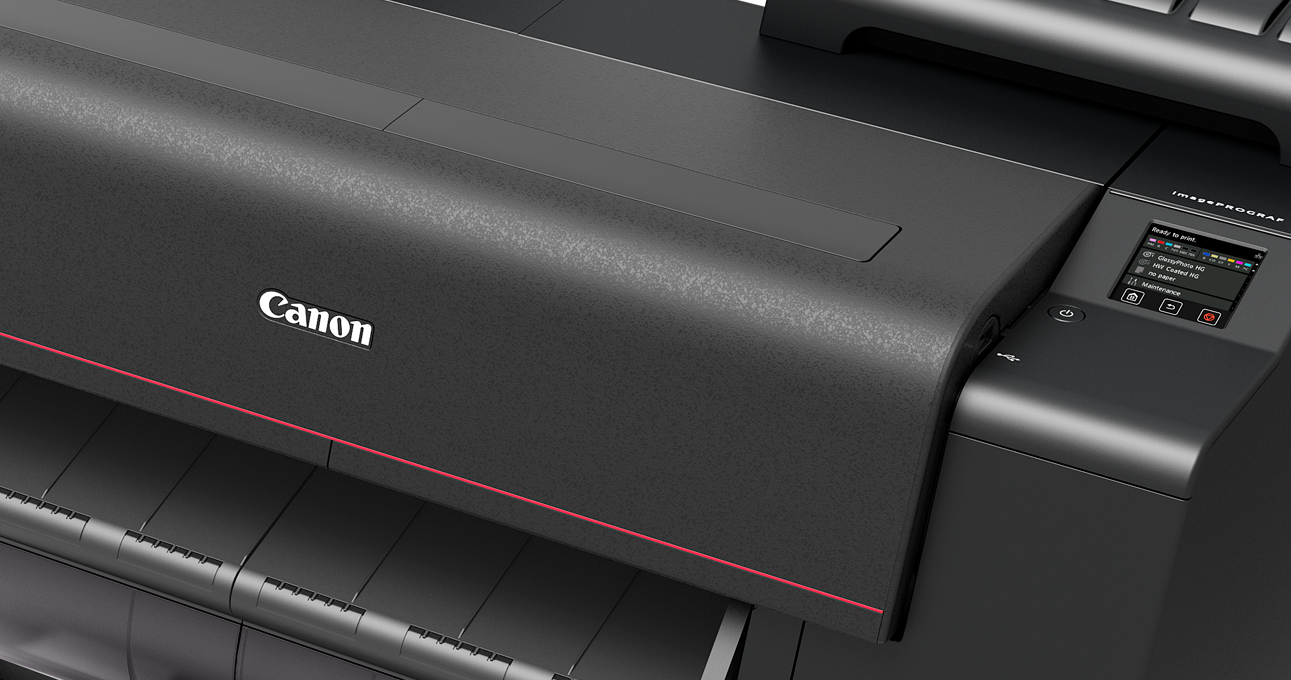
Canon Inkjet
La nota frontiera dei plotter Canon passa attraverso la rivoluzione della stampa Inkjet e Fine Art segnando una nuova era .Con Canon si aprono nuovi orizzonti di business per il mondo degli stampatori in quanto oggi è possibile ottenere, tramite un processo industriale, un prodotto di assoluta qualità e pregio artistico che arriva fino alla produzione di photo-album su carte Fine Art sviluppate ad hoc da Canon per la tecnologia inkjet.
Con una risoluzione nativa di 2400 dpi - quasi 10 volte superiore alle attuali tecnologie di stampa chimica - la stampa inkjet Canon mostra dettagli mai visti prima in una fotografia. Confrontando la stessa immagine stampata con le due tecnologie, la differenza risulta particolarmente evidente per colori più vivi e dettagli più nitidi che prima erano poco visibili.

Canon Inkjet
The popular frontier of the Canon plotters goes through the revolution of Inkjet and Fine Art printing, marking a new age.With Canon, new business horizons open up in the printing sector, beacuse today it is possible to obtain, through an industrial process, a product of absolute quality and artistic value: the production of photo books on Fine Art papers developed specifically by Canon for inkjet technology.
With a native resolution of 2400 dpi - almost 10 times higher than current c-print technologies - Canon inkjet prints show details never seen before in a photo.

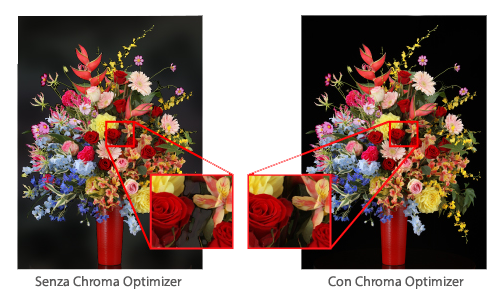
CHROMA OPTIMIZER
Il nuovo sistema di protezione di stampe professionali
L'efficacia consiste in una linearizzazione adhoc sulle carte Inkjet professionali associato alla nuova cartuccia ChromaOptimizer che consente di ottenere colori precisi e una resa ottimale dell'immagine.Prodotto unicamente su Canon Pro2100 e Pro4100 Pro-6100 il risultato sarà una stampa perfettamente impermeabile.
Questo percorso ci porta verso un nuovo modo di pensare la stampa, sulla strada dell' innovazione e della qualità.
GUARDA IL VIDEO
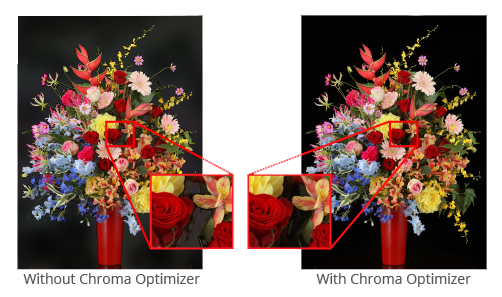
CHROMA OPTIMIZER
The new protection system of professional prints
The effectiveness consists of an adhoc linearization on professional Inkjet papers associated with the new cartridge ChromaOptimizer. This system allows you to obtain precise colors and optimal image rendering.It was produced only for Canon Pro2100, Pro4100, Pro-6100 and the result will be a perfectly waterproof print.
This path leads us to a new way of thinking about printing, on the way of innovation and quality.
WATCH THE VIDEO
PRO AND AGAINST the c-print VS INKJET print
Let’s take a close look at the pros and cons of lab and pigment prints based on important factors. Hopefully this information will help guide you in making the right decision.While there will always be fierce debate between supporters of traditional photo lab prints and proponents of inkjet technology, the facts speak for themselves. The ultimate decision depends on how much you value color gamut and longevity versus cost, personal aesthetics, and the target market if selling your work.
| Inkjet Prints | Digital C-Prints |
| Print Permanence | Print Volume and Production Speed |
| Color Gamut | |
| Paper Selection | |
| Paper Size Selection | |
| Acceptable File Formats / Color Spaces | |
| Environmental Considerations | |
| Artist Control | |
| Museum + Gallery Acceptance (Tie) |
DURABLE AND QUALITY PHOTOS
Let there be no doubt that inkjet pigment prints will outlast C-prints by a wide margin. Since C-prints are dye-based, they are more susceptible to deterioration than inkjet pigment prints when exposed to light, heat and humidity, even when framed behind glass. In addition, dye coupler staining is an issue with C-prints over time. In fact, inkjet dye prints have greater longevity than chemical dye prints. Revised studies by Henry Wilhelm (Founder of Wilhelm Imaging Research) using improved test criteria dropped longevity estimates for Silver-halide paper (under typical display conditions) to 20 years, down from the 60-year figure quoted in older studies. In stark contrast, inkjet pigment ink prints can last for over 200 years on a true archival paper, under proper environmental and display conditions.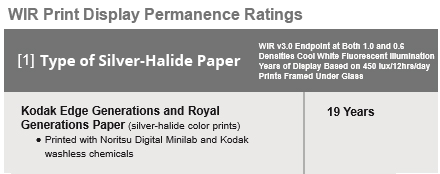
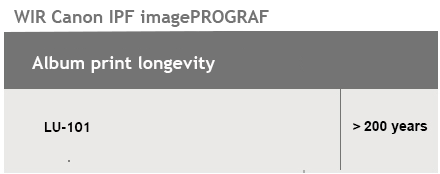
COLOR GAMUT
The advantage goes to inkjet pigment prints.There is no doubt that today professional inkjet pigment printers can reproduce colors next to that of the Adobe RGB color space, into ProPhoto RGB territory.
ProPhoto RGB is the only color space large enough to contain all the colors a camera’s sensor can capture. Of course color gamut depends on the quality of the ICC profile, ink set, printer and paper used.
In contrast, photo lab print gamuts range from sRGB coverage (or less), to partial Adobe RGB coverage. One exception lies in the area of very saturated blues and magentas.
Inkjet printers use a greater range of color inks, both dye and pigment, than any other printing process. In addition, inkjet pigment prints exhibit greater contrast, smoother color gradations, deeper blacks (Dmax), and finer shadow details than chemical dye prints.
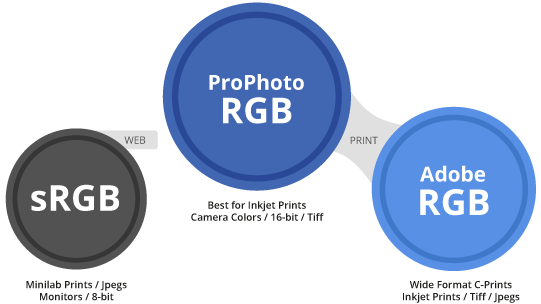
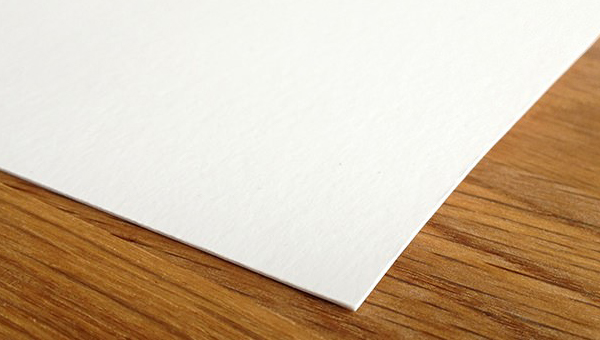
PAPER SELECTION
Again, the advantage goes to inkjet pigment prints. Today there is an astonishing number of excellent papers, both photo and matte, available for inkjet printing.From canvas, cotton and kozo (mulberry), to baryta and bamboo, this diverse selection of papers allows for the personalized expression of your image in print.
On the other hand, photo lab print paper selection is very limited in comparison.
Note that overall, C-prints are more sturdy and less fragile than inkjet prints, and are less susceptible to scratching and scuffing. Of course this depends on the paper.
HISTORY OF THE PHOTOGRAPHIC PRINTING IN TIME
Toward the end of the 19th century most photographic images were captured with sensitized silver salts coated on cumbersome glass plates. After exposure to light, the plates were chemically developed which formed a reversed or negative image, hence the term "negative". After the negative image was "fixed", the photographer created a positive print by individually contacting the negative with a sensitized paper which was then chemically developed. The process was complicated and expensive, and amateur photographers were few.In the late 19th century flexible roll film became commercially viable. This film, which could be transported through smaller more portable hand-held cameras, allowed users to make numerous exposures. With no heavy, rigid, breakable glass plates involved, producing photographic prints became relatively easy. Soon non-professionals took up photography.
In 1951 inkjet printing was born. The ink is pushed towards the nozzle and then it is sprayed into tiny drops on the surface. This happens in two ways:
- through the use of a piezoelectric crystal which, when it is beaten by the current, it bends and drops a drop of ink on the support;
- through heating of ink to create a bubble getting bigger, than the bubble explodes and hit the paper.
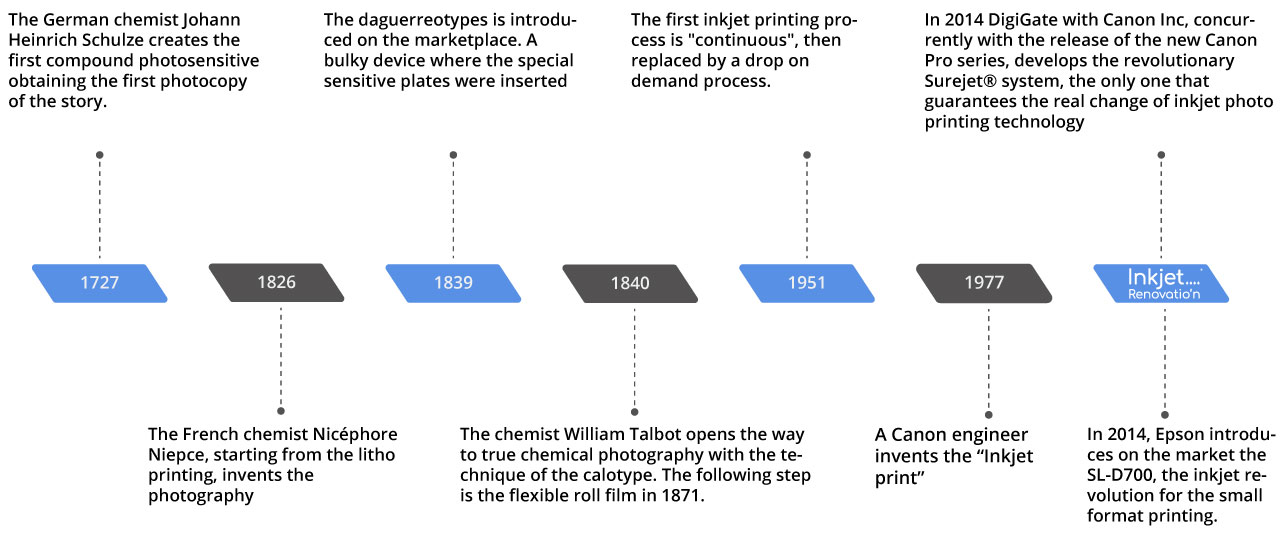
PRINTING SOLUTION
Digigate is able to offer you a system of equipment, supplies and supports necessary to guarantee immediate, fast and quality printing services, in complete autonomy with the lowest possible ink consumption. Infact, the low cost of printing (only and exclusive Digigate) makes our system the most competitive among all. The profiling and the calibration made adhoc exclusively with professional equipment, confer to the system the best quality result and real low printing costs.
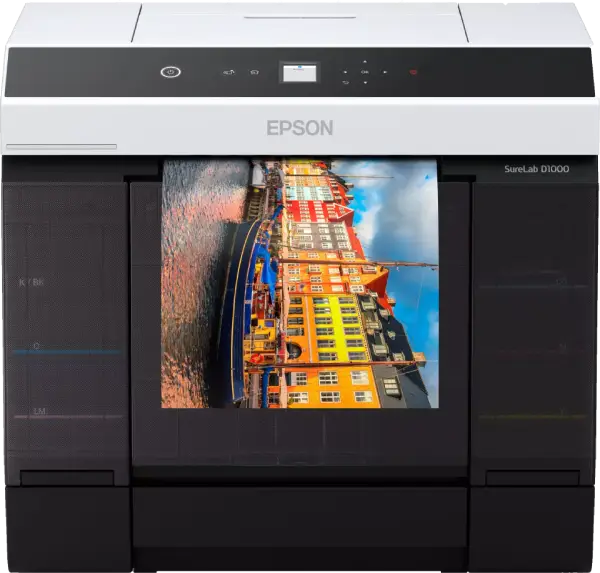
EPSON SURELAB SL-D1000/SL-D1000A
SL-D1000 consente di stampare fotografie, cartoline, inviti, volantini e brochure promozionali in numerosi formati e su un'ampia gamma di supporti, inclusa la carta in rotolo con finitura lucida, patinata od opaca con larghezza di 89-210 mm e lunghezza di 5-100 cm. Grazie alla testina di stampa Epson Micro Piezo e alla tecnologia di elaborazione delle immagini, insieme con gli inchiostri originali Epson, SureLab SL-D1000 assicura stampe nitide e ben definite- Testina di stampa Epson Micro Piezo e tecnologia di elaborazione delle immagini Epson
- Set di inchiostri Epson UltraChrome D6r-S a 6 colori
- Taglierina resistente e lunghi intervalli di manutenzione
- Dimensioni ridotte e ampia gamma di supporti e formati di stampa (carta lucida, satinata ed opaca).
- Stampa di fotografie fronte/retro Cassetto fronte/retro (fino a 100 fogli A4) per una produzione con alimentazione automatica (disponibile solo su SL-D1000A)
- Dimensioni ridotte e ampia gamma di supporti e formati di stampa (carta lucida, satinata ed opaca).

EPSON SURELAB SL-D1000/SL-D1000A
The SL-D1000 allows you to print photographs, postcards, invitations, flyers and promotional brochures in numerous formats and on a wide range of media, including roll paper with a glossy, coated or matte finish with a width of 89-210 mm and a length of 5-100cm. Thanks to the Epson Micro Piezo print head and image processing technology, together with the original Epson inks, SureLab SL-D1000 ensures sharp and well-defined prints- Epson Micro Piezo printhead and Epson image processing technology
- Epson UltraChrome D6r-S 6-color ink set
- Resistant cutter and long maintenance intervals
- Small size and wide range of media and print formats (glossy, satin and matte paper).
- Double-sided photo printing Duplex tray (up to 100 A4 sheets) for auto-feed production (only available on SL-D1000A)
- Small size and wide range of media and print formats (glossy, satin and matte paper).

POWER PLOTTER
Software Rip per la stampa di immagini su stampanti di grande formato. Punti di forza del programma sono il modulo di linearizzazione multicanale ed il software di profilazione interno (modulo opzionale) proprietari, che consentono una qualità di stampa sempre al Top. Disponibile per Windows e Mac.
- File processabili: Tiff, JPEG, BMP, PS/ EPS/PDF 1.6 e HPGL/ HPGLII
- Gestione file PS e PDF multipagina, possibilità di scegliere le pagine e gestirne il nesting (automatico o manuale) sul tavolo di montaggio
- Gestione ritaglio immagine sul tavolo di montaggio
- Gestione avanzata della coda di stampa (stampa, archivia, cambia ordine…)
- Curve di output per la modifica dei colori in uscita con preview
- Cost Manager Lite - Software di gestione dei costi di stampa che permette di conoscere i consumi di ogni stampa, conservando nelle statistiche solo gli ultimi 5 lavori effettuati
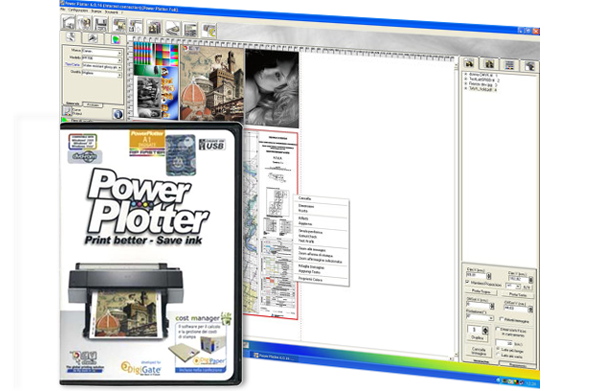
POWER PLOTTER
Software Rip to print images on large format printers. The key points of the software are the multichannel linearization module and the internal profiler (optional) , both developed by DevStudio, that always allow a top level print quality. Avalaible for Windows and Mac.
- Processable files: Tiff, JPEG, BMP, PS/ EPS/PDF 1.6 and HPGL/ HPGLII
- PSD file management and multi-page PDF, automatic and manual Nesting up to 99 images
- Cutting and nesting on the work space
- Management of 3 queues/Hot Folders, possibility to work in "Queue Mode"
- The software gives the user the possibility to make color correction (with preview) directly on the print using curves and sliders
- Cost Manager: software for the calculation of the printing costs of printers and LFPs


KIOSK CON SOFTWARE DILAND
Computer Kiosk 24" HP con display touchscreen, interfaccia grafica intuitiva e per questo è ideale per il software Diland. Sistema operativo Windows 10, processore AMD di ultima generazione e ampio spazio di archiviazione.Software Diland per preparare gli ordini di stampa di immagini digitali.
I canali e i formati di stampa sono completamente personalizzabili: fototessere, stampe con bordo, provini, composizioni, gadget, fotolibri, archiviazione.
Indirizza automaticamente gli ordini a stampanti immediate, a minilab, ad altri computer, a laboratori esterni tramite ftp o supporti di archiviazione rimovibili.
Libero inserimento di cornici e calendari per le fotocomposizioni.
Scelta e vendita degli scatti del fotografo professionista.
Inserimento di messaggi, video ed immagini pubblicitarie ad alto impatto visivo.

KIOSK WITH SOFTWARE DILAND
Computer Kiosk 24" HPwith display touchscreen, intuitive graphical interface and for this reason it is ideal for Diland software. Windows 10, processor AMD of last generation and ample storage space.Software Diland
Easy to use touch screen software to create print orders from digital images.
- Print products and channels are easily customizable: passport, borders, contact sheet, cluster, gifts, Photobooks, CDs and DVDs.
- Automatically send print orders to dye-sub printers, minilabs, networked PCs, photofinishers via ftp or removable storage media.
- It is possible to load third party frames and graphics to enable creative products like cards, calendars etc.
- Event photography ordering system with dedicated image sources and price list.
- Digital signage feature with customizable text, video and images for high impact promotional messages.


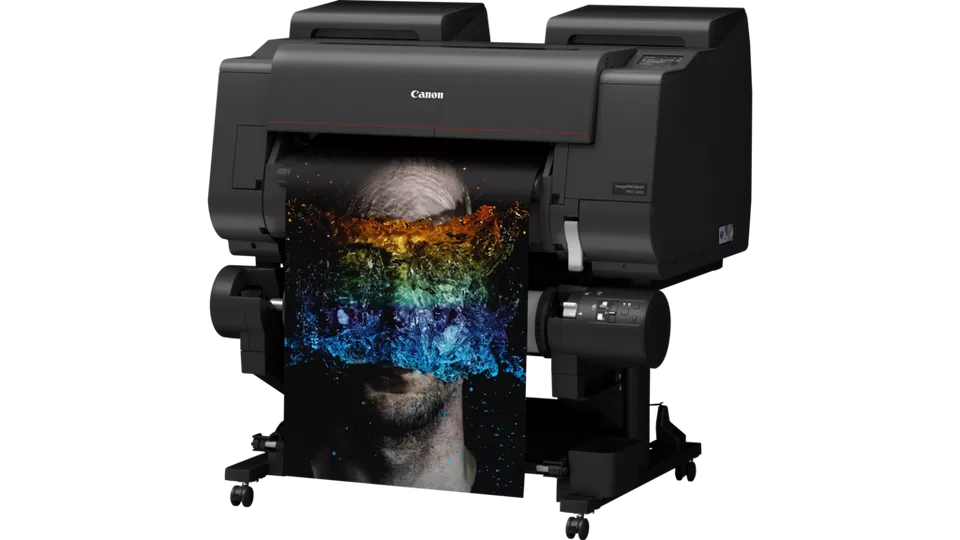
CANON PRO-SERIES
Eccellente produttività e stampe di qualità superiore. Il sistema di inchiostri LUCIA PRO II(12 colori) da abbinare garantisce colori più ricchi e neri più intensi, mentre la testina di stampa da 1,28" assicura stampe veloci senza compromettere la qualità.Pro-2600 24" / Pro-4600 44" / Pro-6600 60"
- Grazie alla tecnologia di inchiostri a pigmenti LUCIA PRO II e a una testina di stampa da 1,28", questi plotter offrono una straordinaria gamma di colori e tonalità eccezionali.
- Il motore L-COA PRO di Canon utilizza algoritmi avanzati e include circuiti integrati per applicazioni specifiche al fine di offrire prestazioni rapide ed efficienti.
- Stampa al vivo su tutti i rotoli personalizzati
- Sono dotate di una testina di stampa intelligente che offre una serie di funzioni, come il doppio rotolo, che assicurano un'elevata velocità di stampa.

CANON PRO-SERIES
Powerful productivity and great prints. The LUCIA PRO II inks (12 colors) are positioned together and the ink system guarantees richer colours and deeper blacks, while the 1.28" print head means faster prints without compromising quality.Pro-2600 24" / Pro-4600 44" / Pro-6600 60"
- Marrying LUCIA PRO II pigment ink technology with 1.28” print head, these plotter deliver a stunning colour gamut and impressive tonal expression.
- Canon’s L-COA PRO engine harnesses advanced algorithms and application-specific integrated circuitry to ensure overall performance is fast and efficient.
- Experience unwavering quality from the PRO-SERIES sturdy frame, which maintains a precise distance between the print head and media while reducing reverberations.
- Bleed printing on all personalized rolls
- The PRO-SERIES benefit from an intelligently configured print head and features such as dual-roll functionality, combining to deliver rapid output speeds..

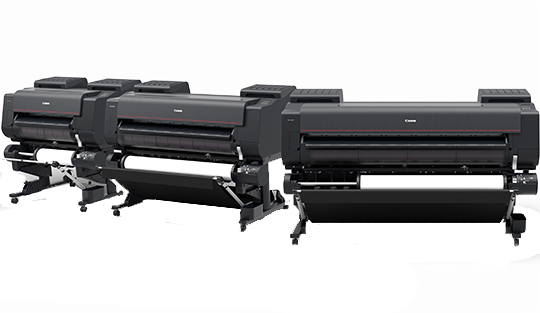
CANON PRO-SERIES
Eccellente produttività e stampe di qualità superiore. Il sistema di inchiostri LUCIA PRO da abbinare garantisce colori più ricchi e neri più intensi, mentre la testina di stampa da 1,28" assicura stampe veloci senza compromettere la qualità.Pro-2100 24" / Pro-4100 44" / Pro-6100 60"
- Grazie alla tecnologia di inchiostri a pigmenti LUCIA PRO (12 colori) e a una testina di stampa da 1,28", questi plotter offrono una straordinaria gamma di colori e tonalità eccezionali.
- Il motore L-COA PRO di Canon utilizza algoritmi avanzati e include circuiti integrati per applicazioni specifiche al fine di offrire prestazioni rapide ed efficienti.
- Stampa al vivo su tutti i rotoli personalizzati
- Sono dotate di una testina di stampa intelligente che offre una serie di funzioni, come il doppio rotolo, che assicurano un'elevata velocità di stampa.

EPSON SURELAB SL-D1000/SL-D1000A
The SL-D1000 allows you to print photographs, postcards, invitations, flyers and promotional brochures in numerous formats and on a wide range of media, including roll paper with a glossy, coated or matte finish with a width of 89-210 mm and a length of 5-100cm. Thanks to the Epson Micro Piezo print head and image processing technology, together with the original Epson inks, SureLab SL-D1000 ensures sharp and well-defined prints- Epson Micro Piezo printhead and Epson image processing technology
- Epson UltraChrome D6r-S 6-color ink set
- Resistant cutter and long maintenance intervals
- Small size and wide range of media and print formats (glossy, satin and matte paper).
- Double-sided photo printing Duplex tray (up to 100 A4 sheets) for auto-feed production (only available on SL-D1000A)
- Small size and wide range of media and print formats (glossy, satin and matte paper).

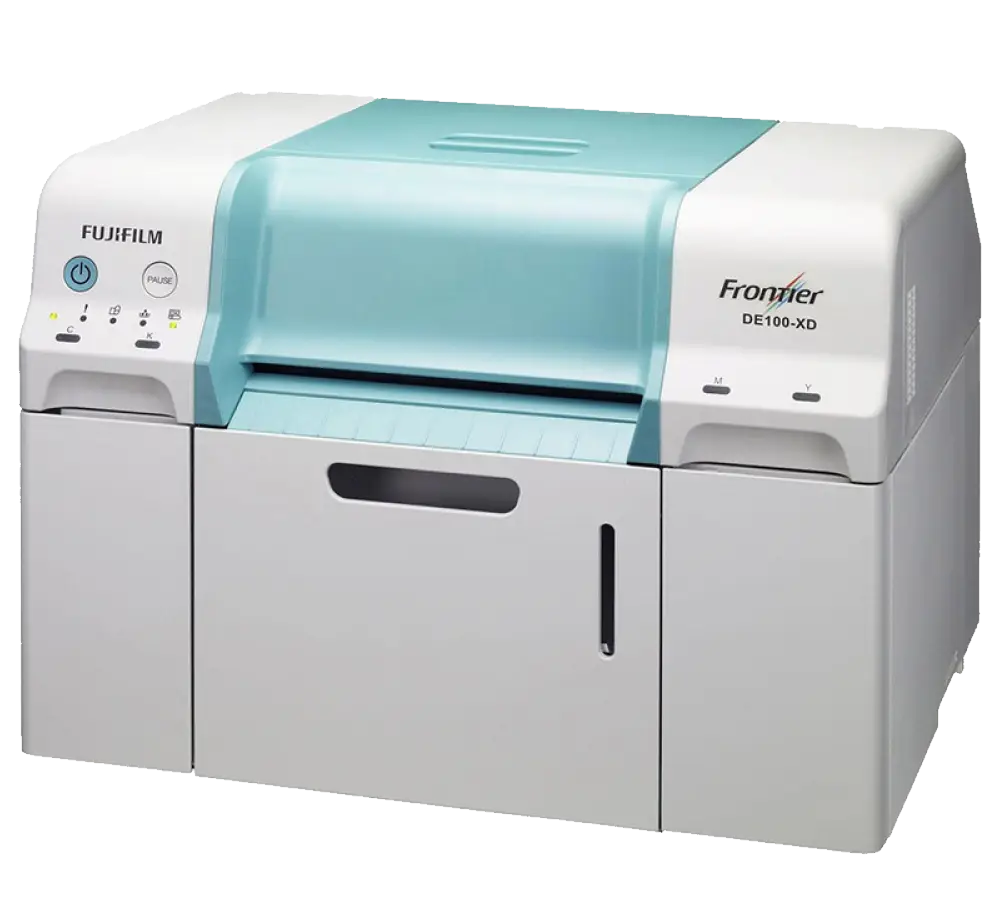
FUJIFILM Frontier DE100-XD
Frontier DE100-XD è una stampante fotografica compatta e ad alte prestazioni, caratterizzata da estrema durata, eccellente qualità delle immagini ed elevata velocità di elaborazione. Inoltre, consente una configurazione flessibile del sistema per produrre più prodotti di stampa fotografica che soddisfano le diverse esigenze del settore fotografico.- Il sistema di inchiostro a 4 colori ad alta viscosità ViViDiA D-photo brevettato da Fujifilm, combinato con una testina di stampa ad alta risoluzione 2.400 × 2.400 dpi, consente un'applicazione molto accurata di gocce di inchiostro di dimensioni molto ridotte, pari a 1 picolitro. In questo modo si ottengono splendide stampe fotografiche dalla grana fine e dalla vivacità senza precedenti.
- Il sistema di inchiostri "VIVIDIA" consente di produrre stampe fotografiche con un'eccellente formazione del colore e un'ampia gamma di riproduzione dei colori.
- DE100-XD supporta vari formati carta, da 89×50 mm a 210×1.000 mm. Tra le altre cose, le stampe fotografiche possono essere stampate in formato portafoglio, 4R, quadrato o anche come banner lungo 1 metro per la decorazione d'interni.

FUJIFILM Frontier DE100-XD
Frontier DE100-XD è una stampante fotografica compatta e ad alte prestazioni, caratterizzata da un'estrema durata, un'eccellente qualità delle immagini e un'elevata velocità di elaborazione. Inoltre, consente una configurazione flessibile del sistema per la produzione di più prodotti di stampa fotografica che soddisfano le diverse esigenze del settore fotografico.- Il sistema di inchiostri a 4 colori ad alta viscosità ViViDiA D-photo, di proprietà di Fujifilm, abbinato a una testina di stampa ad alta risoluzione da 2.400 × 2.400 dpi, consente un'applicazione molto accurata di gocce d'inchiostro di dimensioni ridottissime, pari a 1 picolitro. In questo modo si ottengono splendide stampe fotografiche con una grana fine e una vivacità senza precedenti.
- Il sistema di inchiostri "VIVIDIA" consente di produrre stampe fotografiche con un'eccellente formazione del colore e un'ampia gamma di riproduzione cromatica.
- La DE100-XD supporta diversi formati di carta, da 89×50 mm a 210×1.000 mm. Tra le altre cose, le stampe fotografiche possono essere stampate in formato portafoglio, 4R, quadrato o anche come banner di 1 m di lunghezza per la decorazione di interni.

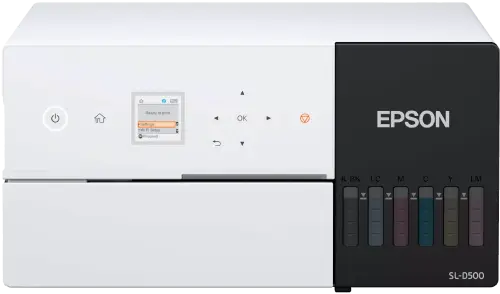
EPSON SURELAB SL-D500
SL-D500 consente di stampare fotografie, cartoline, inviti, volantini e brochure promozionali in numerosi formati e su un'ampia gamma di supporti, dimensioni con finitura lucida, patinata o opaca da 9 cm x 13 cm a 10 cm x 15 cm , Da 3,5 pollici x 5 pollici a 4 pollici x 6 pollici, . Grazie alla testina di stampa Epson Micro Piezo e alla tecnologia di elaborazione delle immagini, insieme agli inchiostri originali Epson, SureLab SL-D500 garantisce stampe nitide e ben definite- Design compatto e impilabile: si adatta perfettamente alla maggior parte degli ambienti di lavoro
- Meno intervento da parte dell'utente: sistema di inchiostro (Ultrachrome® D6r-S) 70 ml CISS (100 fogli ASF)
- Integrazione: interagisce con altre stampanti Epson SureLab, DTG, per segnaletica e LFP
- Fronte/retro automatico
- Connettività: USB, LAN e Wi-Fi

EPSON SURELAB SL-D500
SURELAB SL-D500 is designed for high-quality photo printing of up to one metre in length, it is Epson's first 6-colour compact photo production printer with inkjet technology. It utilises our Micro Piezo printhead and image processing technology, along with our Epson genuine ink for crisp, vivid results. It is ideal if you are looking to print photos, cards, art reproductions and other quality print products.- High-quality: Micro Piezo printhead, Epson’s image processing (LUT technology)
- Wide gamut: 6-colour ink-set
- Prints on a wide range of media: Glossy, lustre and paper-based matte
- Reliable: Long-lasting cutter blade, long service intervals
- Outstanding flexibility: Compact size, wide range of media and print size
DIGIPAPER
Wide range of papers and supports for inkjet printing, from photographic paper to canvas, to fineart, to special support, all tested for the best possible yield.
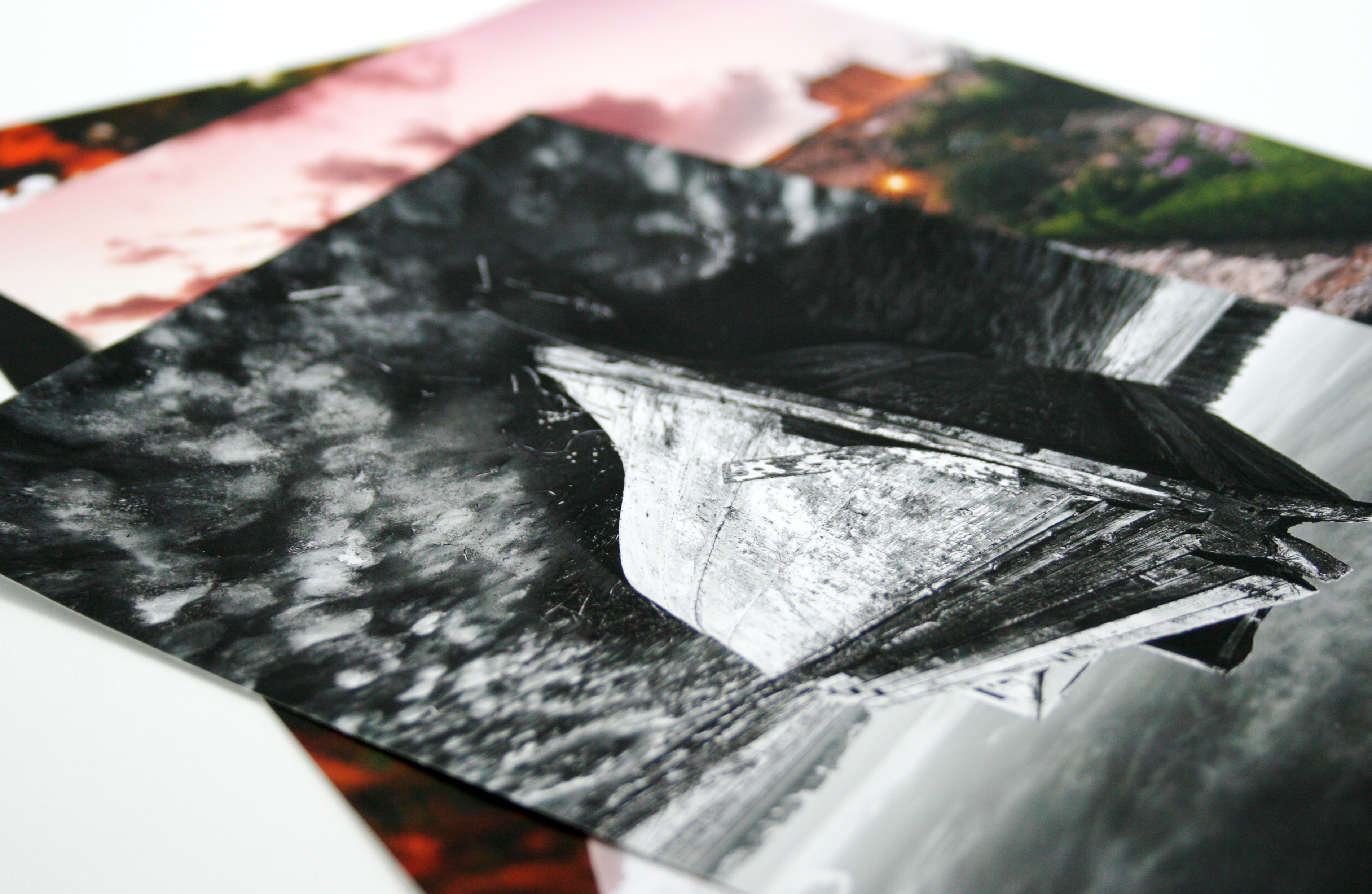
DRYJET MINILAB
Le carte per minilab fotografiche inkjet DRYJET hanno uno spessore maggiore rispetto alle altre e questo le rende indubbiamente di maggiore resistenza e qualità.Sono progettate per essere eco-friendly, ovvero dal bassissimo impatto ambientale.
Sono compatibili con stampanti Epson, Fuji, Noritsu e posseggono sul retro un certificato che ne attesta la qualità e l'originalità.
| Superfici | Grammatura |
| Satin / Glossy | 250 gr |
| Opaco / Seta |
| Bande |
| 10,2 cm x 65 mt 12,7 cm x 65 mt 15,2 cm x 65 mt 20,3 cm x 65 mt 21,0 cm x 65 mt |

DRYJET MINILAB
Inkjet photo papers for minilab are thicker than the others and this makes them undoubtedly of greater strength and quality.They are eco-friendly and have a low environmental impact.
They are compatible with Epson, Fuji, Noritsu printers and they have on their back a certificate that attests their quality and originality.
| Superfaces | Weight |
| Satin / Glossy | 250 gr |
| Roll sizes |
| 10,2 cm x 65 mt 12,7 cm x 65 mt 15,2 cm x 65 mt 20,3 cm x 65 mt |

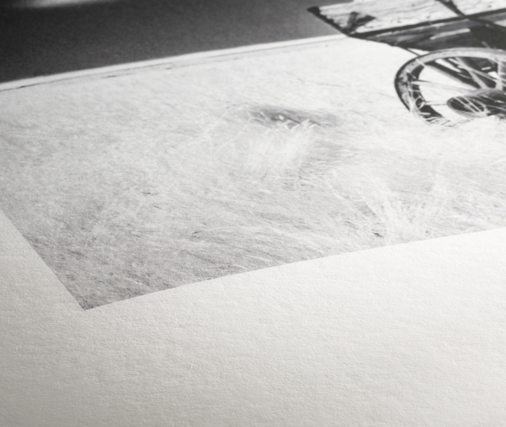
HIGH SMOOTH COTTON
Carta ultra liscia a getto d'inchiostro che offre qualità riproduttive accurate, maggiore longevità e una superficie robusta per stampe eccezionali ma resistenti.Costituita per il 50% da cotone e 50% da cellulosa.
La splendida superficie fine art matte totalmente opaca, ideale per stampe con colori saturi e neri profondi, si integra perfettamente con qualsiasi immagine di alta qualità indipendentemente dal suo genere.
| Superficie | Grammatura |
| Matte | 325gr (fogli) - 292gr (bande) |
| Bande |
|
31 cm x 30 mt 61 cm x 30 mt |
| Formati |
| A4 - A3 |

HIGH SMOOTH COTTON
Ultra-smooth inkjet paper that guarantees accurate reproductive qualities, increased longevity, and a strong surface for exceptional but durable prints.It consists of 50% cotton and 50% cellulose.
The splendid surface Fine Art matte totally opaque, ideal for prints with saturated colors and deep blacks, it integrates perfectly with any high quality image independently of type.
| Surface | Weight |
| Matte | 325gr (sheet) 292gr (roll size) |
| Roll sizes |
|
31 cm x 30 mt 61 cm x 30 mt |
| Sheet format |
| A4 - A3 |

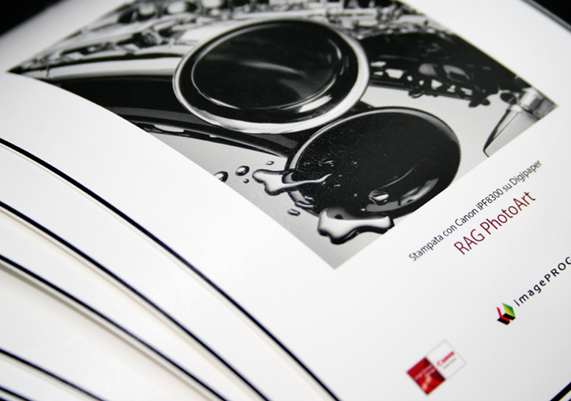
RAG PHOTOART BARYTA
DigiPaper Rag PhotoArt Baryta presenta uno strato inkjet rivestito direttamente di un vero barite (solfato di bario) e strato di base in fibra per la riproduzione dei colori vividi, bianchi cremosi e neri vellutati per il look unico della tradizionale foto di alogenuro di carta argento. Questo versatile supporto è perfetto per le immagini a colori, con vivacità e profondità o per la produzione di simpatiche ri-creazioni di un'immagine tradizionale in bianco e nero. Come con vere immagini in bianco e nero, il fotografo può creare l'aspetto di immagini chimicamente seppia, oro, selenio e blu, ma a differenza della tonificazione chimica, il numero di variazioni sono limitate solo dalla fantasia del fotografo.| Superficie | Grammatura |
| Baritata | 287gr |
| Bande |
|
43,2 cm x 20 mt 61 cm x 20 mt 152,4 cm x 20 mt |

RAG PHOTOART BARYTA
DigiPaper Rag PhotoArt Baryta presents an inkjet layer coated directly with a real barite (barium sulfate) and a fiber base layer for the reproduction of vivid colors, creamy whites and velvety blacks for the unique look of the traditional silver halide photo. This versatile support is perfect for the production of nice re-creations of a traditional black and white image. As with true B/N images, the photographer can create the appearance of images chemically sepia color, gold color, selenium and blue, but unlike chemical toning, the number of variations are limited only by the imagination of the photographer.| Surface | Weight |
| Baryta | 287gr |
| Roll Sizes |
|
43,2 cm x 20 mt 61 cm x 20 mt 152,4 cm x 20 mt |

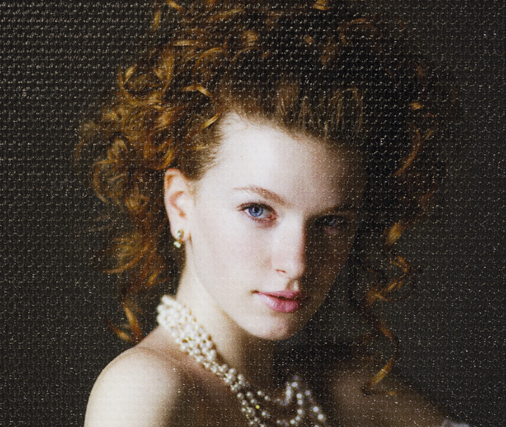
TELE CANVAS POLIESTERE
Le tele poly canvas a differenza delle premium canvas è al 100% poliestere ed è più resistente.La grammatura è 280gr con rifinitura Glossy e Matte a getto d’inchiostro di alta qualità per risultati eccellenti nelle sue diverse applicazioni quali: poster, foto, quadri.
| Superficie | Grammatura |
| Matte / Glossy | 280gr |
| Bande Matte |
|
61 cm x 30,50 mt 111,8 cm x 30,50 mt 152,4 cm x 30,50 mt |
| Bande Glossy |
| 43,2 cm x 20,25 mt 61 cm x 20,25 mt 111,8 cm x 20,25 mt |

CANVAS POLYESTER
Poly canvas is 100% polyester and more durable.The weight is 280gr, Glossy and Matte finishing, this canvas gets excellent results in its various applications such as: posters, photos, pictures.
| Surfaces | Weight |
| Matte / Glossy | 280gr |
| Roll sizes Matte |
|
61 cm x 30,50 mt 111,8 cm x 30,50 mt 152,4 cm x 30,50 mt |
| Roll sizes Glossy |
| 43,2 cm x 20,25 mt 61 cm x 20,25 mt 111,8 cm x 20,25 mt |

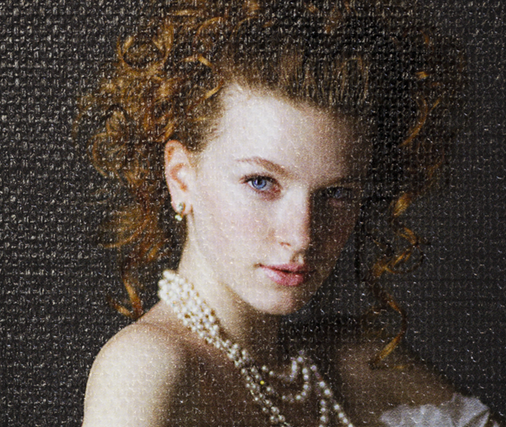
TELE CANVAS COTONE
Le tele premium canvas sono in cotone 100% con grammatura 380 e hanno rifinitura Glossy o Matte.Sono ideali per stampe e poster con colori naturali e molto brillanti o per creare originali oggetti di uso quotidiano con le stampe come borse e accessori.
| Superficie | Grammatura |
| Matte / Glossy | 380gr |
| Bande |
| 43,2 cm x 12,24 mt 61 cm x 12,24 mt 111,8 cm x 12,24 mt 152,4 cm x 12,24 mt |

CANVAS COTTON
The premium canvas are 100% cotton, weight 380gr and Glossy or Matte finishing.They are ideal for prints and posters with natural and very bright colors or to create original objects of daily use with prints such as bags and accessories.
| Surfaces | Weight |
| Matte / Glossy | 380gr |
| Roll sizes |
| 43,2 cm x 12,24 mt 61 cm x 12,24 mt 111,8 cm x 12,24 mt 152,4 cm x 12,24 mt |

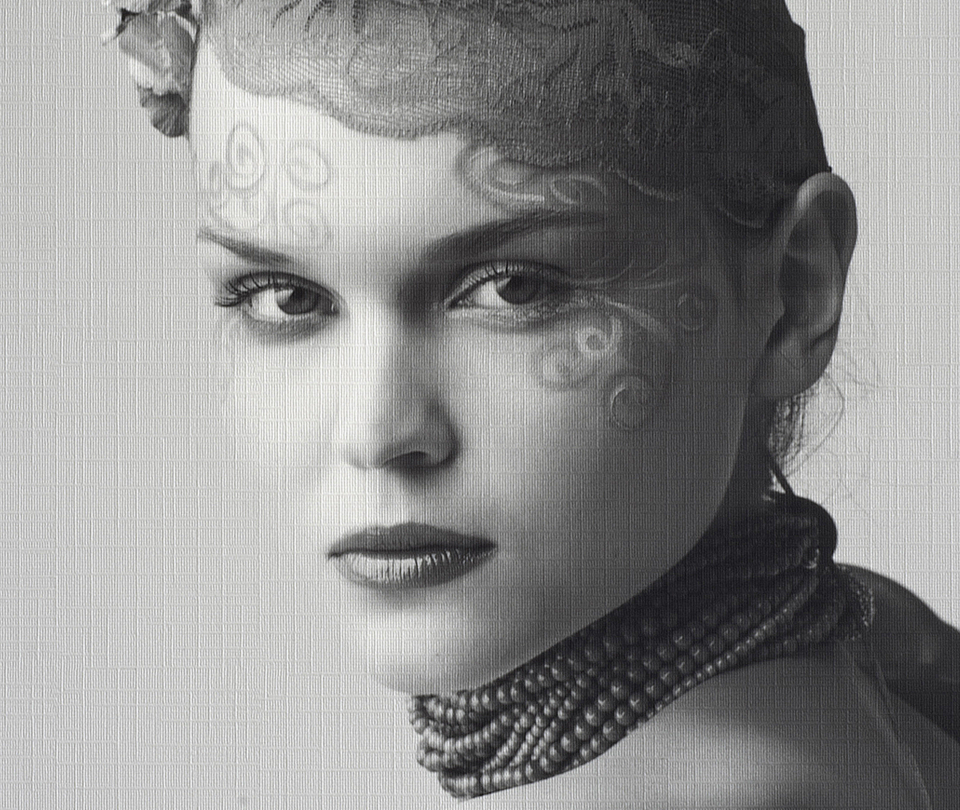
SUPERIOR MATTE TEXTURED
Carte artistiche inkjet FINE ART, sono perfette per le applicazioni di stampa creative che vanno da fotografie d'arte, portafogli e album di opuscoli di fascia alta, inviti, calendari e presentazioni.Resistente alla cordonatura per fotolibri digitali, Photobook
Trame disponibili:
| Superficie | Grammatura |
| Matte | 237gr |
| Bande |
| 43,2 cm x 30 mt 51,2 cm x 30 mt 61 cm x 30 mt |

SUPERIOR MATTE TEXTURED
Artistic paper inkjet FINE ART, Superior matte textured are perfect for creative printing applications such as art photographs, wallets and high-end booklet, invitations, calendars and presentations.Resistant to creasing for digital Photobook
Textures available:
| Superface | Weight |
| Matte | 237gr |
| Roll sizes |
| 43,2 cm x 30 mt 51,2 cm x 30 mt 61 cm x 30 mt |

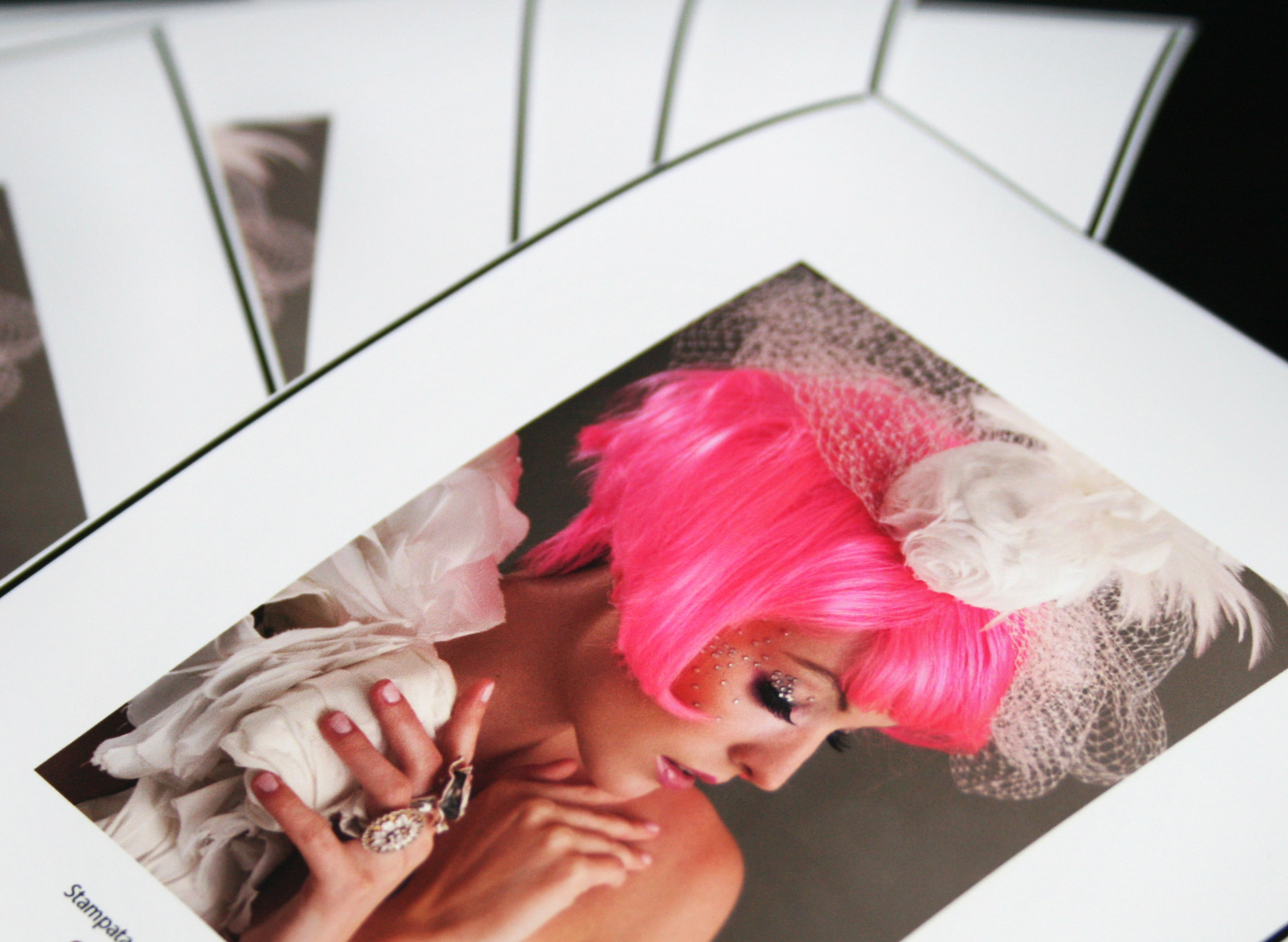
SUPERIOR MATTE
Carta Digipaper Opaca/Matte/Patinata di altissima qualità con superficie ultra liscia (Ultra Smooth).La superior matte è ideale per stampe e poster con colori naturali e molto brillanti.
Ideale per stampare FotoLibri o creare inserti artistici in quanto ha un elevata resistenza alla manipolazione e una splendida texture.
Carta compatibile con Plotter Canon, Epson e Hp
| Superficie | Grammatura |
| Matte | 237gr |
| Bande | |
| 30,6 cm x 30 mt | 35,4 cm x 30 mt |
| 43,2 cm x 30 mt | 50,8 cm x 30 mt |
| 51cm x 30mt | 61 cm x 30 mt |
| 111,8 cm x 30 mt | 152,4 cm x 30 mt |
Plotter e Minilab
21 cm x 30 mt - 237gr

SUPERIOR MATTE
Digipaper Matte/Patinated paper of the high quality with ultra smooth surface.Ideal for prints and posters with natural and very bright colors.
Ideal to print PhotoBooks or to create artistic inserts because it has a high resistance to creasing and a beautiful texture.
Paper compatible with Plotter Canon, Epson and Hp
| Superface | Weight |
| Matte | 237gr |
| Roll sizes | |
| 30,6 cm x 30 mt | 35,4 cm x 30 mt |
| 43,2 cm x 30 mt | 50,8 cm x 30 mt |
| 51cm x 30mt | 61 cm x 30 mt |
| 111,8 cm x 30 mt | 152,4 cm x 30 mt |
Plotter and Minilab
21 cm x 30 mt - 237gr

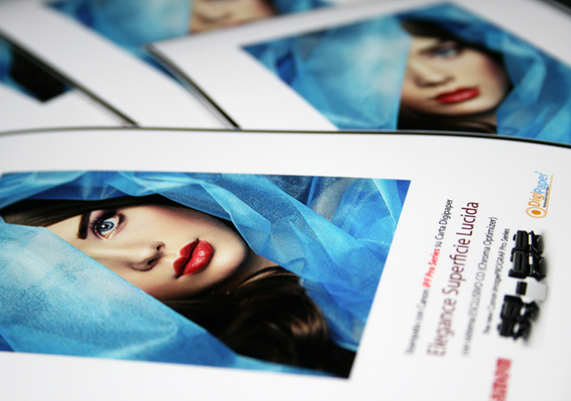
ELEGANCE
Carta Fotografica Inkjet professionale con superficie GLOSSY - LUCIDA.Ideale per stampe e poster con colori naturali e molto brillanti
Resistente alla cordonatura per Photobook.
| Superficie | |
| Glossy | |
| Bande per plotter | |
| 30,5cm x 85mt - 290gr | 31,2cm x 30mt - 260gr |
| 43,2cm x 30mt - 250gr | 61cm x 30mt - 250gr |
| 111,8cm x 30mt - 260gr | 152,4cm x 30mt - 250gr |
| Bande per minilab | |
| 10,2cm x 65mt - 250gr | 12,7cm x 65mt - 250gr |
| 15,2cm x 65mt - 250gr | 20,3cm x 65mt - 250gr |
| Formati | |
| A3 - 270gr | 10x15cm - 270gr |
| A4 - 270gr |

ELEGANCE
Professional Inkjet Photo Paper with Glossy finishing.Ideal for posters and posters with natural and very bright colors.
Resistant to creasing for digital Photobook
| Superface | |
| Glossy | |
| Roll sizes plotter | |
| 30,5cm x 85mt - 290gr | 31,2cm x 30mt - 260gr |
| 43,2cm x 30mt - 250gr | 61cm x 30mt - 250gr |
| 111,8cm x 30mt - 260gr | 152,4cm x 30mt - 250gr |
| Roll sizes minilab | |
| 10,2cm x 65mt - 250gr | 12,7cm x 65mt - 250gr |
| 15,2cm x 65mt - 250gr | 20,3cm x 65mt - 250gr |
| Sheet Format | |
| A3 - 270gr | 10x15cm - 270gr |
| A4 - 270gr |

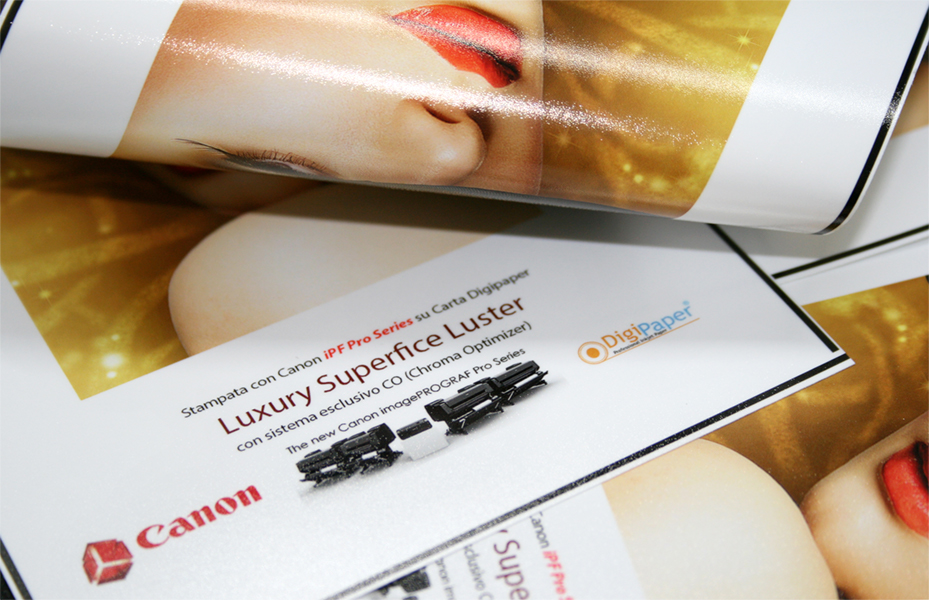
LUXURY
Carta Fotografica Inkjet professionale con superficie Luster. La luxury offre qualità riproduttive accurate, maggiore longevità e una superficie robusta per stampe eccezionali ma resistenti. La splendida superficie luster, si integra perfettamente con qualsiasi immagine di alta qualità.| Superficie | Grammatura |
| Luster | 250gr |
| Bande per plotter | |
| 30,5 cm x 30 mt | 31,2 cm x 30 mt |
| 43,2cm x 30mt | 43,2 cm x 40 mt |
| 51,2 cm x 30 mt | 61 cm x 30 mt |
| 111,8 cm x 30 mt | 152,3 cm x 30 mt |
| Bande per minilab | |
| 10,2 cm x 65 mt | 12,7 cm x 65 mt |
| 15,2 cm x 65 mt | 20,3 cm x 65 mt |
| Formati | |
| A3 | A4 |
| A3 F/R | A4 F/R |

LUXURY
Professional Inkjet Photo Paper with Pearl finishing. This paper offers accurate reproductive qualities, increased longevity and a robust surface for durable prints. The splendid Luster surface, ideal for prints with deep saturated colors and blacks, integrates perfectly with any high quality image.| Surface | Weight |
| Luster | 250gr |
| Roll sizes plotter | |
| 30,5 cm x 30 mt | 31,2 cm x 30 mt |
| 43,2cm x 30mt | 43,2 cm x 40 mt |
| 51,2 cm x 30 mt | 61 cm x 30 mt |
| 111,8 cm x 30 mt | 152,3 cm x 30 mt |
| Roll sizes minilab | |
| 10,2 cm x 65 mt | 12,7 cm x 65 mt |
| 15,2 cm x 65 mt | 20,3 cm x 65 mt |
| Sheet Format | |
| A3 | A4 |
| A3 F/R | A4 F/R |


PRESTIGE ULTRA LUSTRE-PEARL
La carta professionale DigiPaper Prestige Lustre-Pearl è stata ideata per offrire la migliore saturazione colore e la più alta fedeltà possibile. Presenta una piacevole finitura superficiale luster/perlata che, grazie alla sua eccelsa qualità, conferisce brillantezza ed aumenta il valore tonale sia su stampe a colori che in bianco e nero. Compatibile con Plotter Canon, Epson e Hp- 60% più planare rispetto alle altre carte;
- Maggiore densità e profondità della superficie;
- Resistenza migliorata alla cordonatura ed ai graffi.
| Superficie | Grammatura |
| Lustre-Pearl | 260 gr |
| Bande | |
| 25,4 cm x 30 mt | 31 cm x 30 mt |
| 35,7 cm x 30 mt | 43,2 cm x 30 mt |
| 51 cm x 30 mt | 61 cm x 30 mt |
| 111,8 cm x 30 mt |

PRESTIGE ULTRE LUSTRE-PEARL
The DigiPaper Prestige Lustre-Pearl professional paper is designed to offer the best color saturation and the highest possible fidelity. It has a pleasant luster / pearl finishing that, thanks to its excellent quality, gives brightness and increases the tonal value both on color prints and on B/N prints. Compatible with Plotter Canon, Epson and Hp- 60% more plane than other papers;
- Greater density and depth of the surface;
- Improved resistance to creasing and scratches.
| Superface | Weight |
| Lustre-Pearl | 260 gr |
| Roll sizes | |
| 25,4 cm x 30 mt | 31 cm x 30 mt |
| 35,7 cm x 30 mt | 43,2 cm x 30 mt |
| 51 cm x 30 mt | 61 cm x 30 mt |
| 111,8 cm x 30 mt |


ROYAL
Carta Fotografica Inkjet professionale con superficie lucida o perlata. Offre qualità riproduttive accurate, maggiore longevità e una superficie robusta per stampe eccezionali. La tecnologia di rivestimento a getto d'inchiostro nanoporoso, che garantisce che le stampe non solo siano asciutte al tatto direttamente dalla stampante, ma che siano compatibili con tutti i produttori di stampanti più comuni.| Superfici | Grammatura |
| Satin / Pearl | 250 gr |
| Bande (Pearl) | Bande (Glossy) |
| 25,4 cm x 30 mt 30,6 cm x 30 mt 31,2 cm x 30 mt 35,7 cm x 30 mt 43,2 cm x 30 mt 51,2 cm x 30 mt 61 cm x 30 mt 111,8 cm x 30 mt |
25,4 cm x 30 mt 31,2 cm x 30 mt 43,2 cm x 30 mt 51,2 cm x 30 mt 61 cm x 30 mt |

ROYAL
Professional Inkjet photo papers with pearl and glossy surface| Surface | Weight |
| Satin / Pearl | 250 gr |
| Roll Size (Pearl) | Roll Size (Glossy) |
| 25,4 cm x 30 mt 30,6 cm x 30 mt 31,2 cm x 30 mt 35,7 cm x 30 mt 43,2 cm x 30 mt 51,2 cm x 30 mt 61 cm x 30 mt 111,8 cm x 30 mt |
25,4 cm x 30 mt 31,2 cm x 30 mt 43,2 cm x 30 mt 51,2 cm x 30 mt 61 cm x 30 mt |


CRYSTAL
Carta Fotografica professionale con superficie Silk (seta). Al tatto rivela una piacevole sensazione simile al contatto con un delicato tessuto setoso di cui si avverte la trama. Compatibile con inchiostri a Pigmenti e Dye.| Superfici | Grammatura |
| Silk / Seta | 260 gr |
| Bande |
| 30,5 cm x 30 mt 31,2 cm x 30 mt 43,2 cm x 30 mt 51,2 cm x 30 mt 61 cm x 30 mt 111,8 cm x 30 mt |

CRYSTAL
Professional Inkjet paper with Silk surface. To the touch it reveals a pleasant sensation similar to the contact with a delicate silky fabric. It is compatible with Pigments and Dye inks.| Surface | Weight |
| Silk | 260 gr |
| Paper Roll |
| 30,5 cm x 30 mt 31,2 cm x 30 mt 43,2 cm x 30 mt 51,2 cm x 30 mt 61 cm x 30 mt 111,8 cm x 30 mt |
SEND US A MESSAGE
All rights reserved, reproduction of parts of the site is prohibited - Designed by Digigate - Privacy Policy


